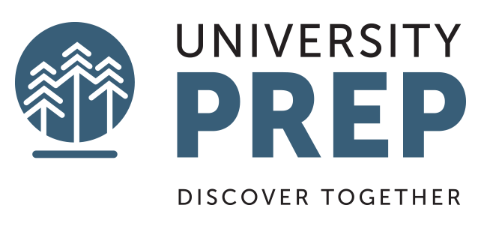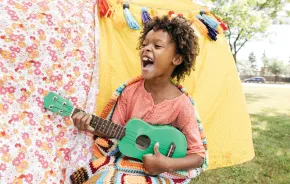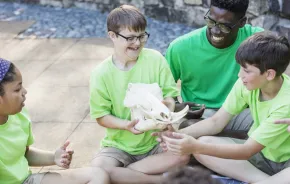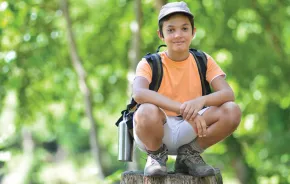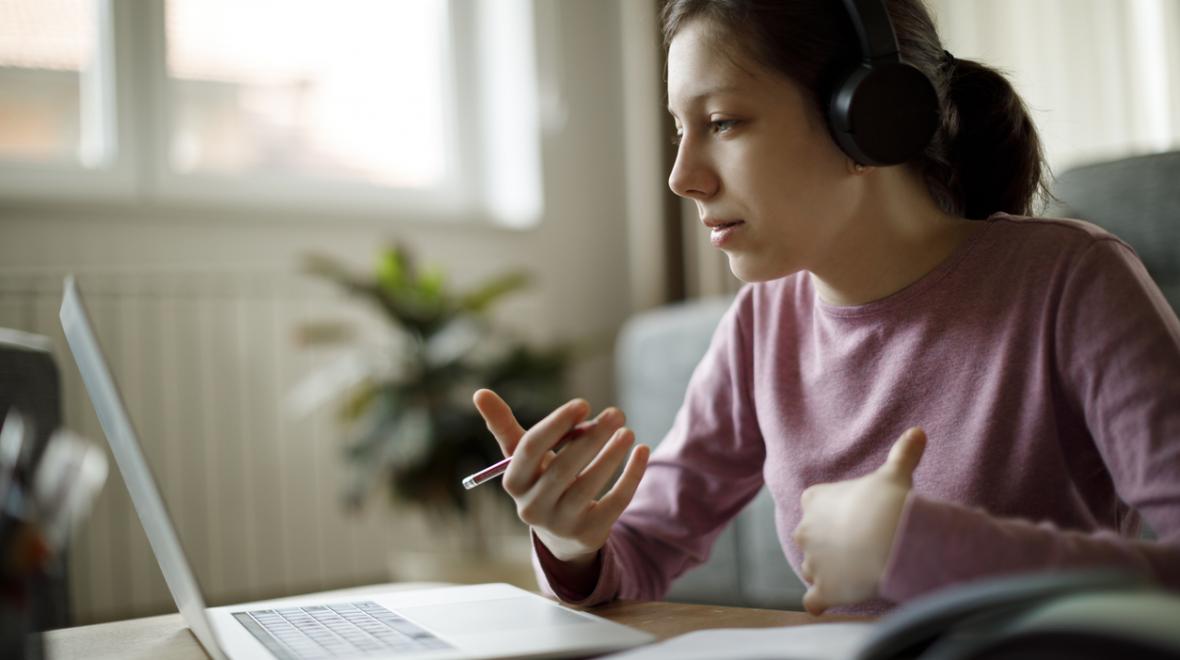
Editor's note: This article was sponsored by University Prep.
The 2020–21 school year has commenced, and it’s already one for the record books. A majority of students across the country are resuming instruction via some version of remote learning, and pandemic-drained parents are strapping in for the ride. But the journey doesn’t have to be a bumpy one, according to Lindsay Metcalfe, a counselor at University Prep, a college prep independent middle and high school in Northeast Seattle.
This spring, when the COVID-19 pandemic upended the normal course of everything, educators, students and parents got their first training-wheels lessons in online learning. A collective imperative to support our students in extraordinary circumstances quickly refocused an emphasis on supporting their social and emotional well-being, first and foremost.
Metcalfe, a 10-year veteran school counselor, says the lessons and necessary constraints of the pandemic gave educators insight into what our students need to stabilize their day-to-day academic and social-emotional foundations in order to scaffold resilient learning.
As this nonstandard school year commenced, we had the chance to catch up with Metcalfe to talk about the unique stress students are experiencing and her insights into how parents and school staff can help them manage anxiety, build resilience and visualize new goals.
What does parental emotional support for teens look like during this time of heightened stress?
My first piece of advice for parents: Don’t assume that you know how your child feels or that how they felt yesterday is the same as how they feel today. I encourage parents to listen to understand. Then paraphrase back what you hear from your student to check that you’re understanding correctly, to demonstrate to them that you get it. Sometimes, that’s enough. Sometimes just the listening and mirroring back what you heard can get them through that moment. I can’t overemphasize how important listening to young people is. They want so badly to feel heard and understood.
When we see our child having a problem, we really want to jump in and solve it. It’s hard to take a step back from that. What is far more powerful for the student, both in the short term and the long term, is to guide them in brainstorming their own solutions. A good place to start is with the question, “What are you going to do about this?” Keep asking, keep checking in with them. [Let them know] “If I’m not the person who can help you and there’s someone else who can, then great. Let’s make sure that we make that connection.”
How can parents build a support network for their children beyond the home?
I think school provides so much connection and community for students, with many options of people who they can talk to, beyond their immediate family. Those conversations and connections do take a little bit more intentionality right now. At UPrep, every adult wants to do whatever they can for these students, so we are really prioritizing social and emotional well-being this school year.
Teachers play a really important role in facilitating connections between students. Our teachers are spending triple the time they normally would in getting to know their students, building class norms and providing opportunities for kids to talk with each other. That’s a good jumping-off place to broaden the students’ network of support.
How are teachers adding in social-emotional learning during online learning at UPrep?
UPrep’s director of social and emotional learning and I hosted a professional development workshop for faculty over the summer, and we brainstormed strategies to support students. That could include dedicated time to talk about issues of equity and justice, both in and out of class, and weaving in opportunities for students to connect with their teacher and their classmates during class time. Last spring, students told us they wanted more time to connect with each other and to talk about issues of equity and justice. Teachers are also explicitly teaching skills to students to help them manage uncertain circumstances.
What did you learn last spring that might help parents during this school year?
I think routine really served our students well in the spring. We had all of our classes continue to happen live and that was a big lift for us as a community. That structure was so helpful for our students because it kept providing opportunities to connect and a sense of normalcy. [A consistent routine] helps take some of that mental load off of our students and allows them to free up their brain power for other things, like school.
How can parents intentionally make space for healthy detachment and development during this time?
It’s a fine line to walk, because the overall path is for teens to separate from the family and form their own identities and their own adult personas, but that isn’t a linear process and it happens in bursts. And then there are also moments where they regress a little bit. I saw it in the spring, when there were a lot of families that were frustrated and experiencing a little bit of conflict with their children because everybody was in the same space all the time. That’s totally natural and understandable, but there also was an appreciation for a little bit more time together and a little bit more closeness. It’s that push-and-pull of “I want to be separate; I want to be with my friends, and I also need my family.”
What I see is that they really need the support and the comfort that they get from adults, and sometimes they just want to do it on their own. Start by taking the lead from the teen in your life; you can’t decide for them what their needs are on any given day. Sometimes the uncertainty that we see from our students is knowing the adults in their lives don’t have all the answers right now. But I also think that there’s a real opportunity here to show your students that you don’t always have to have the next step figured out, but that you trust yourself to do your best on any given day.
I will say that I’ve seen it get a little bit better since many families have started forming small pods that they can safely socialize with. And when that pod includes a same-age peer or, better yet, a friend for the student, there are so many benefits to that. Even just motivation to get them out of their room and off their screens to go hang out with somebody else — that’s big. And I also think that it communicates to the student that their friendships are a family priority, and that feels good to them.
Beyond that, I think it can be really helpful to give your adolescent some increased choice and independence at home. All the ways that kids normally spend their time — those options have been greatly reduced. The more that we can give them some say in how they spend their free time — within reason — the more agency they will feel. I think that that benefits everyone in the family.
What if a parent is having a mounting concern that their teen may need some additional support that the parent is perhaps not equipped to provide (or may not be well-received)?
We’ve had to shift the warning signs that we look for under the current circumstances, just because some of the classic signs of a mental health issue, such as withdrawing from friends or favorite activities, aren’t as easy to observe right now. At the same time, some of the other things that normally are warning signs, such as increased irritability, are ubiquitous. And so, how do you know when we’re having a reasonable reaction to these circumstances versus a larger issue with mental health and safety?
First, look at your child’s overall level of functioning. Are they doing at least most of what needs to happen in school? Are they interacting at some level with family and friends? On any given day, are you seeing both positive and negative emotions from them? If those answers are yes, then they’re probably doing okay. If you’re seeing an area of life where they’re not functioning well, then that is worthy of increased attention.
Obviously, we know that it’s much easier to intervene early and get connected with a counselor or a therapist before their mental health worsens, but the pandemic has impacted virtually everyone’s mental health in some way. The silver lining of that is that I have found students to be much more accepting of help because they have an identifiable stressor that validates their need for that support. Students have been more willing to seek counseling, more willing to talk to the adults in their lives, because they can start the conversation with, “The coronavirus is making me miserable.” That’s an easier opener than, “I feel depressed,” or something along those lines.
If COVID-19 is forcing us to reimagine the school year, how can parents help their kids visualize and reach for new goals?
In a moment when our normal structures have been transformed, I think many of us feel like this is something that’s happening to us and we’re just along for the ride and trying to stay afloat. But I think it’s also an opportunity to think about what’s truly important to us and to build our capacity to adapt and bounce back. The first piece in that process is having students examine their values and priorities, in and out of school. Were they living those values before the pandemic? How about now? How can we better align ourselves with the parts of life that we find important?
Then, I would say that I’m always really impressed by the creativity of young people. I think that this is probably a moment when we can take a step back and listen to their ideas about where we go from here. If your student felt that they were overscheduled before the pandemic, ask them what changes they see as realistic. Kids have a talent for getting to the root of an issue, and I find that they often propose some pretty brilliant solutions.
I also think that this is a really good time for a cognitive reframe. Shifting from uncertainty about the state of the world and the future to curiosity might be a reasonable change to make. That’s not something that’s going to happen overnight. You can’t just decide, “I’m going to be curious and not worry about things anymore,” but I think that we do ourselves a favor every time we see our current situation as a moment for positive change as opposed to something that we’re stuck in.




